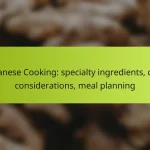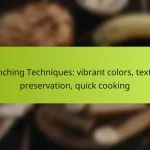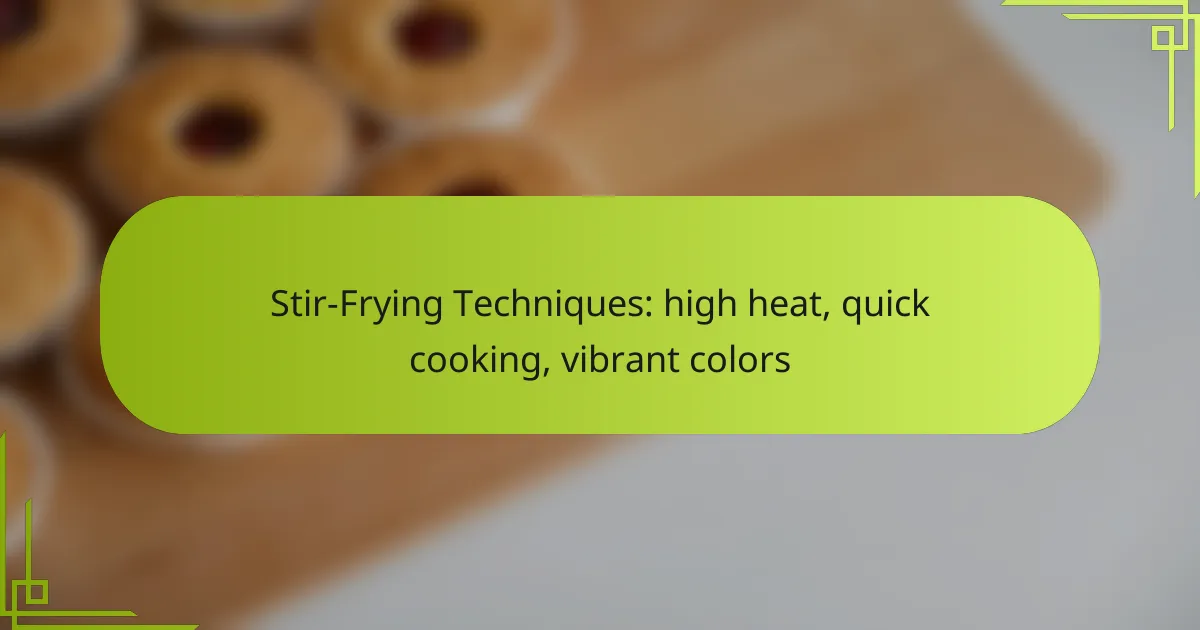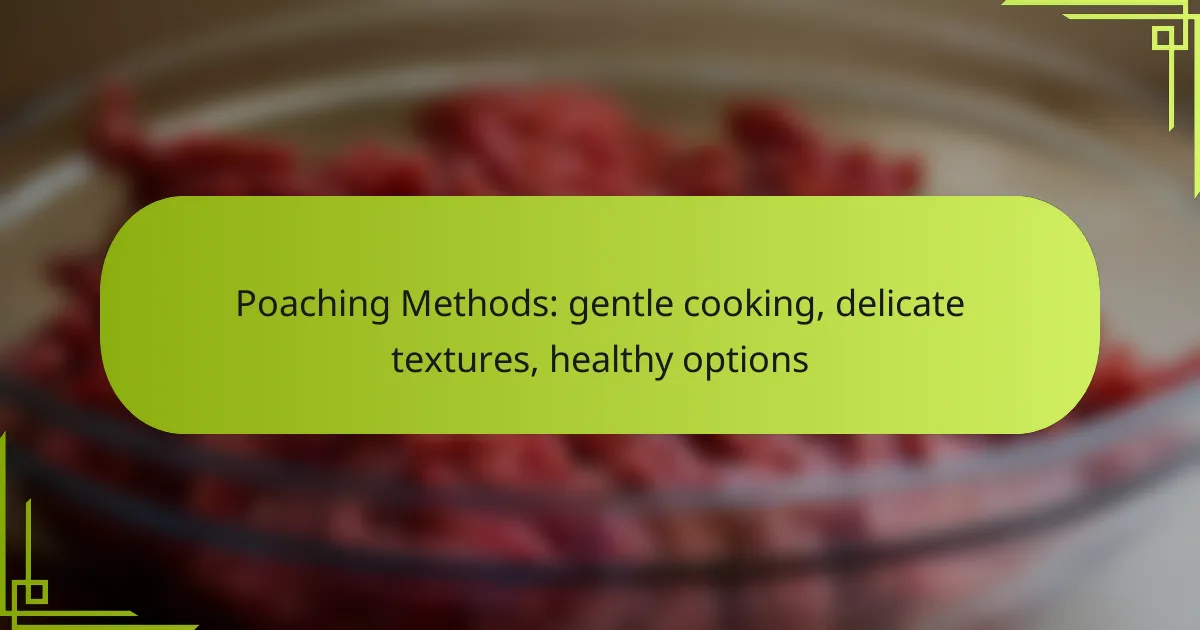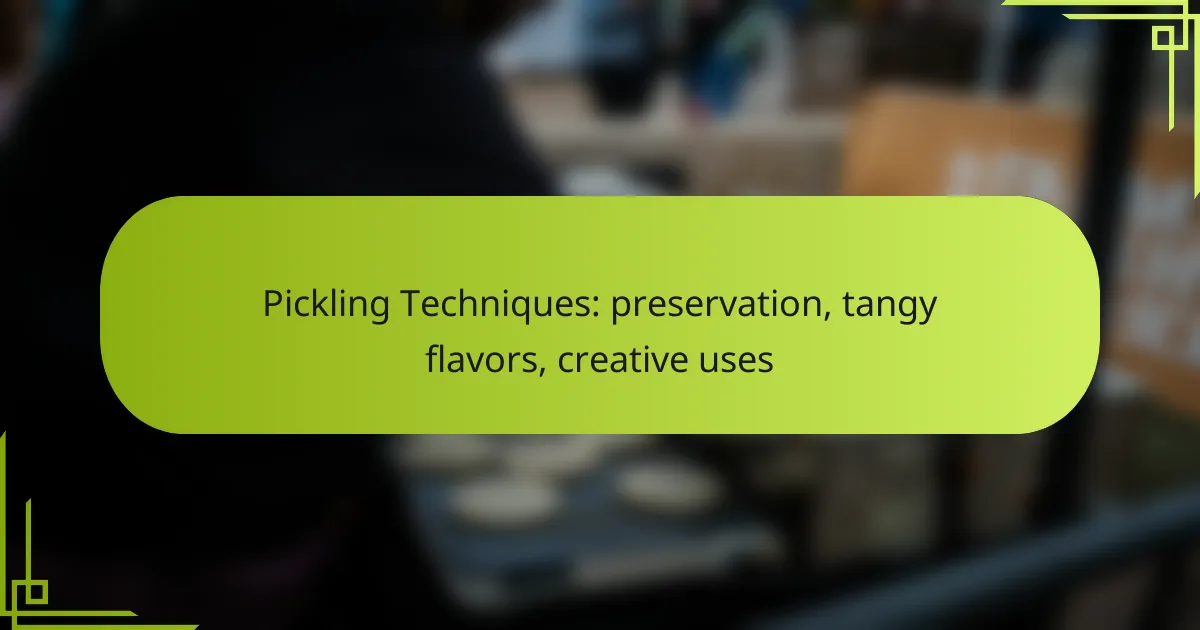Blanching is a culinary technique that involves briefly cooking vegetables in boiling water to enhance their vibrant colors and preserve their texture. This method not only brightens the natural hues of the vegetables but also helps maintain their nutritional value. By mastering the timing and cooling process, you can achieve perfectly cooked vegetables that are ideal for freezing or quick cooking.
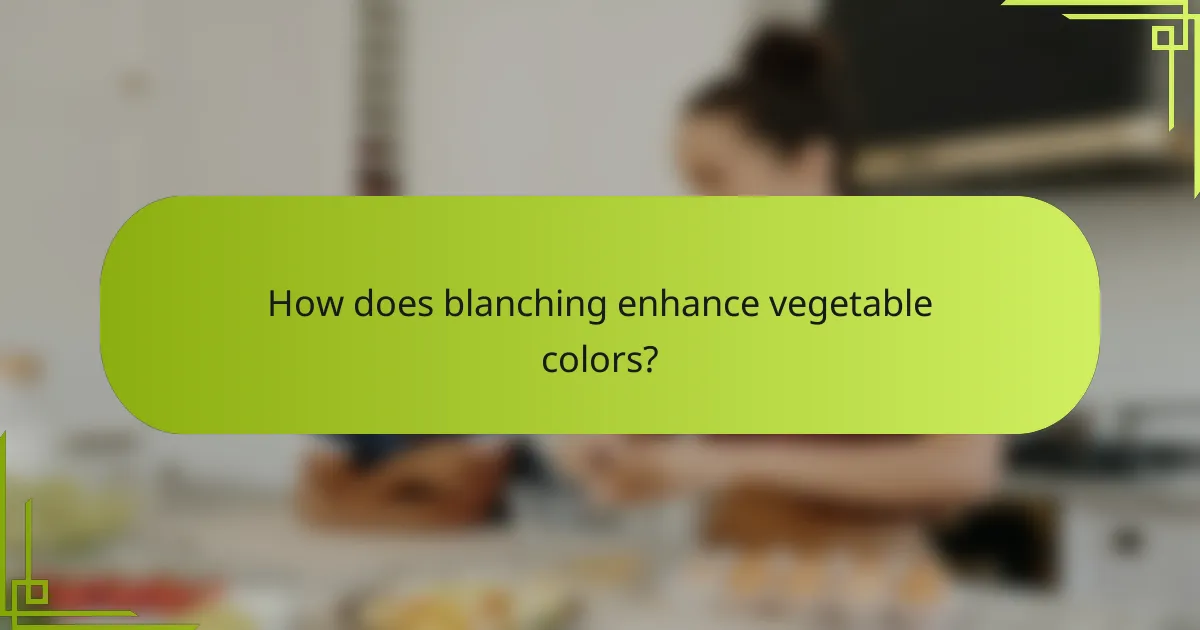
How does blanching enhance vegetable colors?
Blanching enhances vegetable colors by briefly cooking them in boiling water, which helps to set and brighten their natural hues. This technique not only improves the appearance but also preserves the texture and nutritional value of the vegetables.
Preserves vibrant hues
Blanching effectively preserves vibrant hues by deactivating enzymes that can cause color loss. For instance, vegetables like green beans and broccoli retain their bright green color when blanched for a short duration, typically around two to three minutes.
To achieve optimal color retention, immediately transfer the blanched vegetables to an ice bath to halt the cooking process. This quick cooling step is crucial for maintaining the vivid appearance of the vegetables.
Prevents browning reactions
Blanching prevents browning reactions by inactivating polyphenol oxidase, an enzyme responsible for discoloration in fruits and vegetables. For example, apples and pears can turn brown quickly when exposed to air, but blanching them for a brief period can significantly slow this process.
When preparing vegetables for freezing or storage, blanching is essential to minimize browning and maintain quality. A typical blanching time for most vegetables ranges from one to five minutes, depending on the type.
Enhances visual appeal
Blanching enhances the visual appeal of vegetables by making them look fresher and more appetizing. The bright colors and crisp textures achieved through this technique can make dishes more appealing to the eye, encouraging consumption.
In culinary presentations, vibrant, blanched vegetables can serve as a colorful garnish or a key ingredient in salads and stir-fries. Using a variety of blanched vegetables can create a visually stunning plate that highlights freshness and quality.
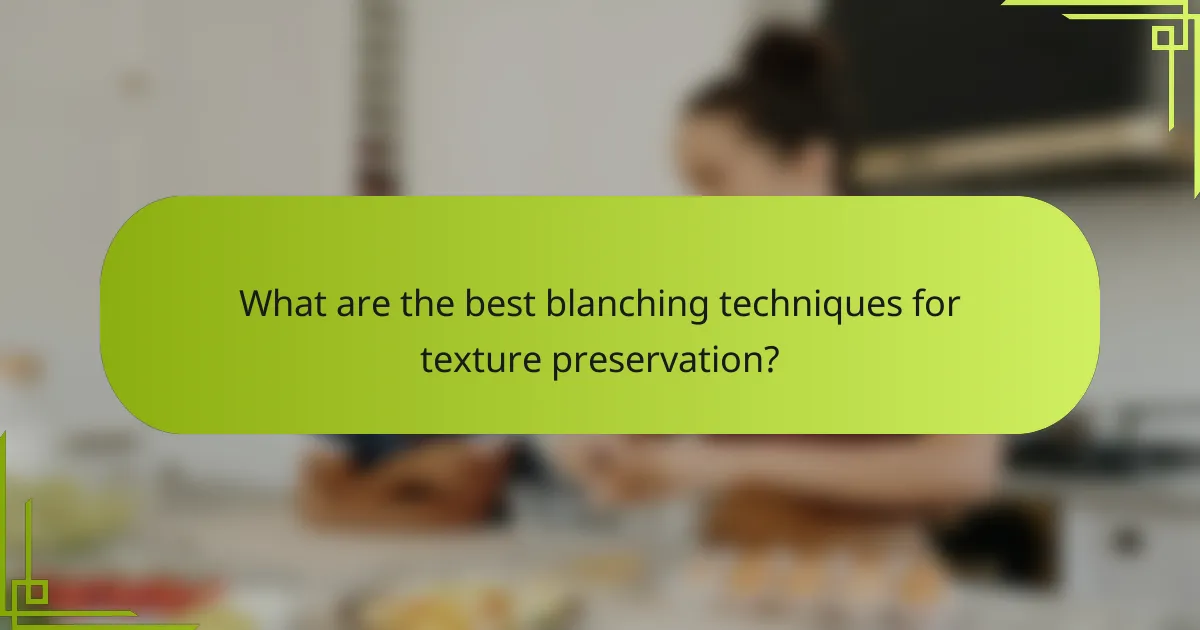
What are the best blanching techniques for texture preservation?
The best blanching techniques for texture preservation involve methods that quickly cook vegetables while maintaining their vibrant colors and crisp textures. Effective blanching requires precise timing and the right cooling process to halt cooking immediately.
Ice water shock method
The ice water shock method is essential for preserving the texture and color of blanched vegetables. After boiling the vegetables for a short period, they should be immediately transferred to a bowl of ice water. This rapid cooling process stops the cooking, locking in the bright colors and crispness.
To implement this technique, prepare a large bowl filled with ice and cold water before starting the blanching process. Once the vegetables are removed from the boiling water, submerge them in the ice water for a duration equal to the boiling time to ensure optimal texture retention.
Timing control for different vegetables
Timing is crucial when blanching, as different vegetables require varying durations to achieve the desired texture. For instance, leafy greens may only need 30 seconds to a minute, while denser vegetables like carrots or broccoli might require 2 to 3 minutes.
To avoid overcooking, keep a timer handy and refer to a blanching guide for specific vegetables. A general rule is to blanch until the vegetables are bright and tender-crisp, then immediately cool them in ice water.
Steam blanching advantages
Steam blanching offers several advantages over traditional boiling methods, particularly in preserving nutrients and texture. By using steam, vegetables are cooked without direct contact with water, reducing nutrient loss and enhancing flavor.
This method typically requires a steamer basket and can take slightly longer than boiling, but it results in firmer textures. For instance, steaming broccoli for about 3 to 5 minutes can yield a vibrant color and crisp bite, making it an excellent choice for those looking to maximize both taste and nutritional value.
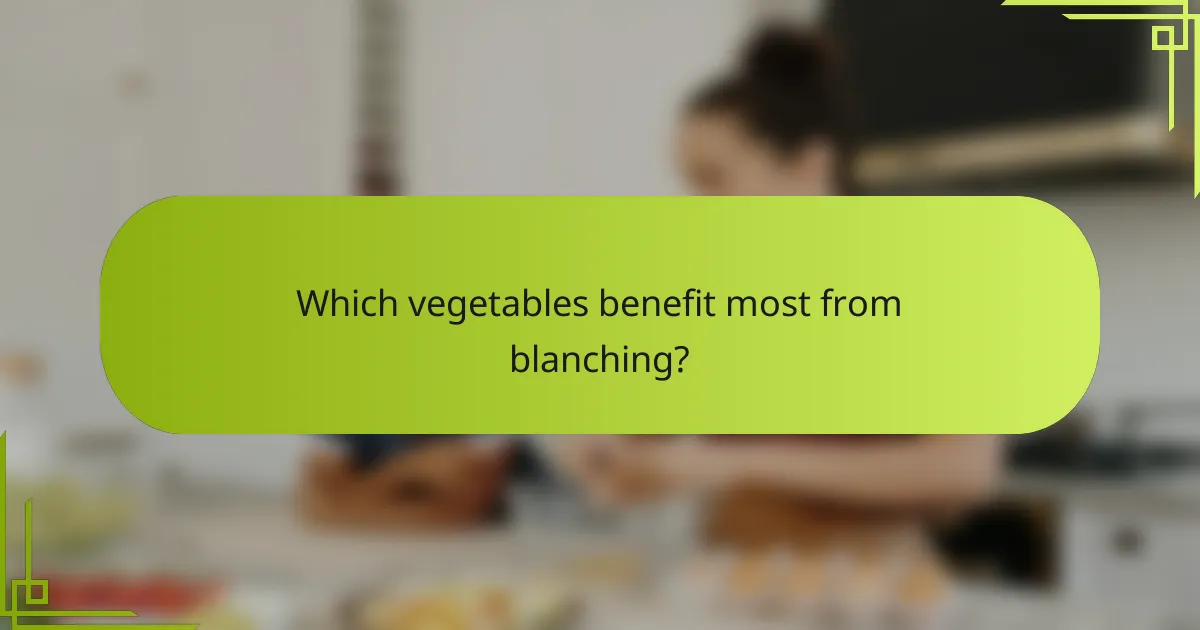
Which vegetables benefit most from blanching?
Vegetables that benefit most from blanching include those that are vibrant in color and have a firm texture. This technique enhances their appearance and preserves nutrients, making them ideal for freezing or quick cooking.
Green beans
Green beans are particularly suited for blanching as it helps maintain their bright green color and crisp texture. Blanching them for about 2-3 minutes in boiling water followed by an ice bath effectively halts the cooking process, ensuring they remain tender yet crunchy.
When preparing green beans, avoid overcooking during blanching, as this can lead to a loss of flavor and nutrients. After blanching, they can be sautéed, added to salads, or frozen for later use.
Broccoli
Broccoli benefits greatly from blanching, which enhances its vibrant green hue and preserves its nutritional value. Blanching for 3-4 minutes in boiling water followed by cooling in ice water is recommended to keep its texture firm and prevent overcooking.
Be cautious not to blanch broccoli for too long, as it can become mushy. Properly blanched broccoli can be used in stir-fries, salads, or as a side dish, and it freezes well for future meals.
Carrots
Carrots are another vegetable that responds well to blanching, which helps to retain their bright orange color and crispness. Blanching carrots for about 2-5 minutes, depending on their size, followed by an ice bath will keep them crunchy and flavorful.
When blanching carrots, cut them into uniform pieces to ensure even cooking. Blanched carrots can be enjoyed raw, added to soups, or frozen for later use, making them a versatile ingredient in various dishes.
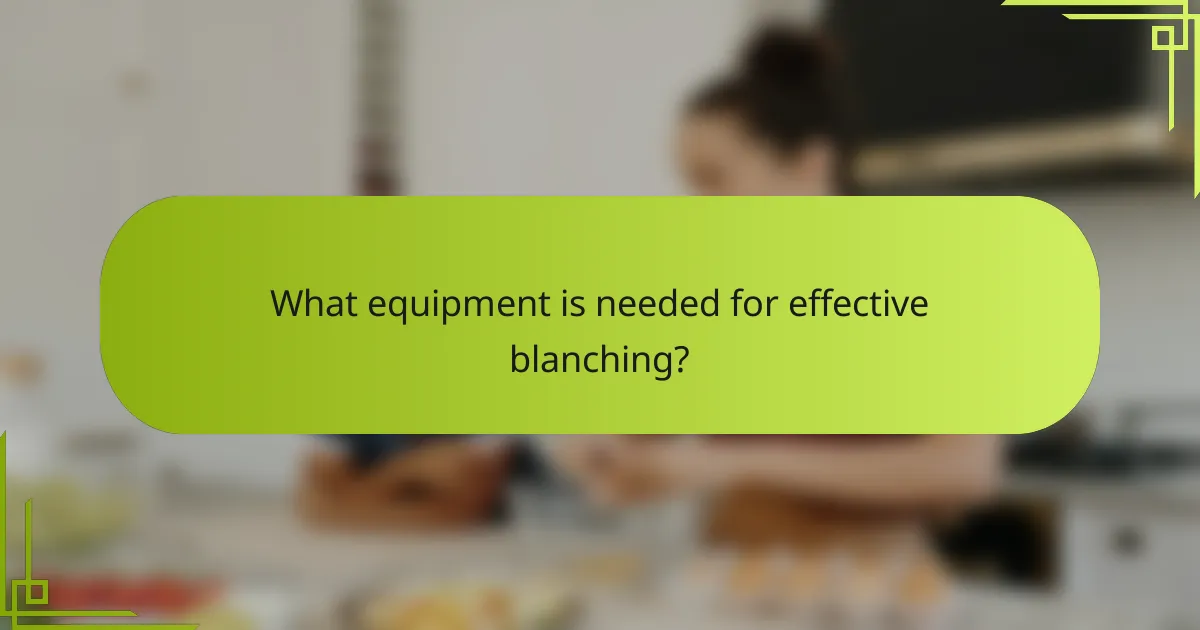
What equipment is needed for effective blanching?
Effective blanching requires a few essential pieces of equipment to ensure vegetables maintain their vibrant colors and textures. The key items include a large pot for boiling, an ice bath container, and a slotted spoon for easy removal.
Large pot for boiling
A large pot is crucial for blanching as it allows enough water to boil rapidly, ensuring even cooking. The pot should be filled with water, typically around 4 to 6 liters, and brought to a rolling boil before adding the vegetables. Using a lid can help the water reach boiling point faster.
When selecting a pot, consider the size of the vegetables you plan to blanch. For larger batches, a stockpot is ideal, while a smaller pot may suffice for single servings. Ensure the pot is made of materials that conduct heat well, such as stainless steel or aluminum.
Ice bath container
An ice bath container is essential for stopping the cooking process immediately after blanching. This can be a large bowl filled with ice and cold water, which should be prepared in advance. The ice bath helps preserve the vegetables’ color and texture by rapidly cooling them down.
When preparing the ice bath, use a ratio of about one part ice to two parts water for optimal cooling. Make sure the container is large enough to accommodate the blanched vegetables without overcrowding, as this can hinder effective cooling.
Slotted spoon for removal
A slotted spoon is a practical tool for removing blanched vegetables from boiling water without excess water clinging to them. This allows for a quick transfer to the ice bath, minimizing the time they spend in hot water. Choose a spoon with a sturdy handle and large slots for efficient draining.
When using the slotted spoon, work quickly to ensure the vegetables are cooled down promptly. Avoid overcrowding the spoon to maintain control and prevent splashing, which can lead to burns or spills.
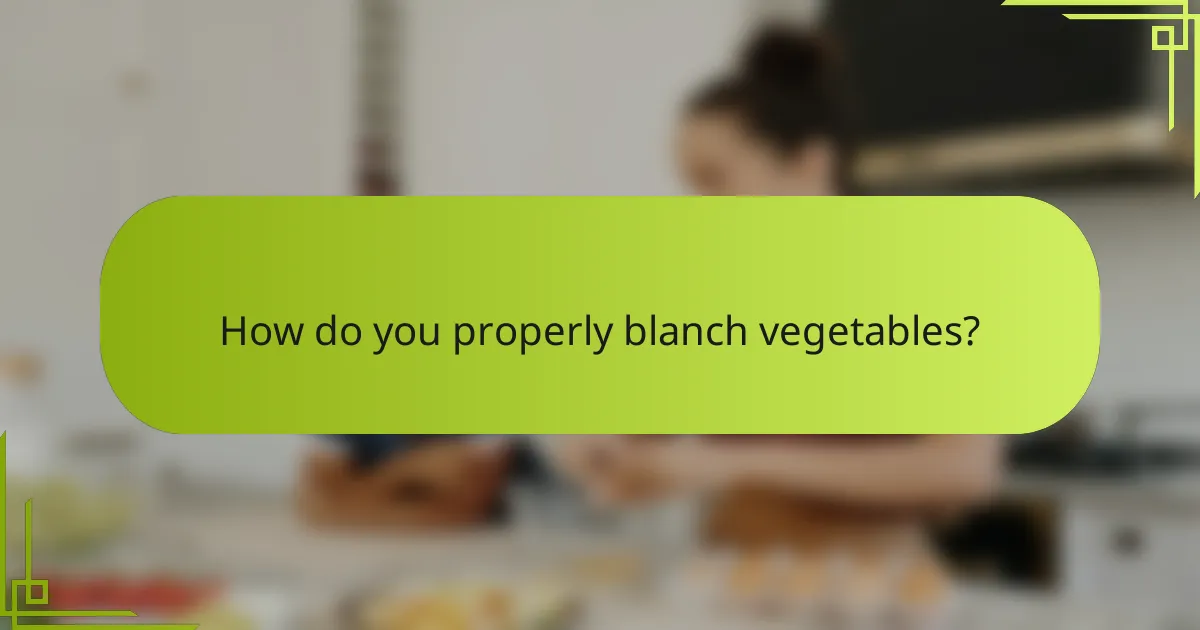
How do you properly blanch vegetables?
To properly blanch vegetables, you need to briefly cook them in boiling water and then quickly cool them in ice water. This technique helps maintain vibrant colors, preserves texture, and enhances the overall flavor of the vegetables.
Step 1: Boil water
Start by bringing a large pot of water to a rolling boil. Use about 1 gallon (approximately 4 liters) of water for every pound (around 450 grams) of vegetables. Adding salt to the water can enhance flavor and help maintain color.
Ensure that the water is at a full boil before adding any vegetables. This initial high temperature is crucial for effective blanching, as it helps to quickly cook the outer layer while keeping the inside crisp.
Step 2: Add vegetables
Carefully add the vegetables to the boiling water in small batches to avoid lowering the water temperature too much. Leafy greens may only need 30 seconds to 1 minute, while denser vegetables like carrots or broccoli may require 2 to 5 minutes.
Monitor the cooking time closely, as overcooking can lead to loss of color and texture. Use a slotted spoon to stir the vegetables gently to ensure even cooking.
Step 3: Shock in ice water
Prepare a bowl of ice water while the vegetables are boiling. Once the cooking time is up, immediately transfer the vegetables to the ice water using a slotted spoon or a strainer. This process, known as shocking, halts the cooking process and helps lock in the bright colors and crisp texture.
Leave the vegetables in the ice water for about the same amount of time they were boiled. Afterward, drain them well and pat dry if you plan to store or use them immediately. Proper shocking is essential for achieving the desired results in blanching.
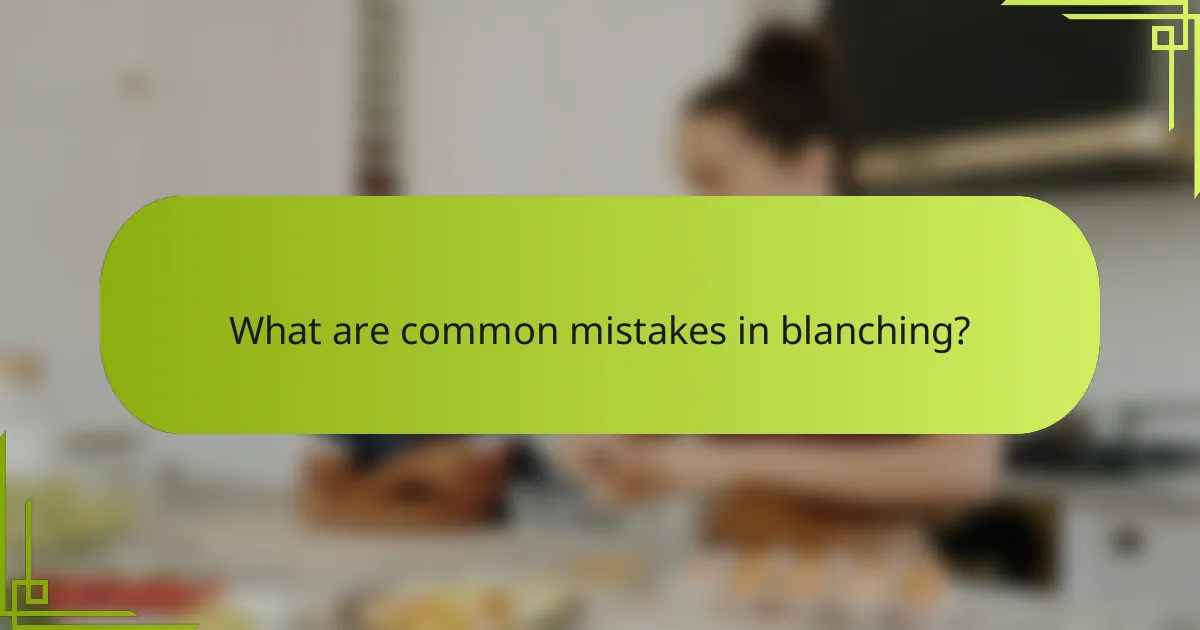
What are common mistakes in blanching?
Common mistakes in blanching include overcooking vegetables, not using enough ice water, and failing to prepare the vegetables properly. These errors can lead to loss of color, texture, and nutritional value, undermining the benefits of this cooking technique.
Overcooking vegetables
Overcooking vegetables during blanching is a frequent mistake that can result in mushy textures and dull colors. The key is to blanch vegetables for a short period, typically ranging from 30 seconds to a few minutes, depending on the type and size of the vegetable.
To avoid overcooking, prepare an ice bath before starting the blanching process. Once the vegetables are blanched, immediately transfer them to the ice bath to halt the cooking process. This method helps maintain vibrant colors and crisp textures.
As a rule of thumb, refer to specific blanching times for different vegetables. For example, green beans may need about 2-3 minutes, while broccoli florets might require only 1-2 minutes. Always keep a close eye on the clock to ensure optimal results.


